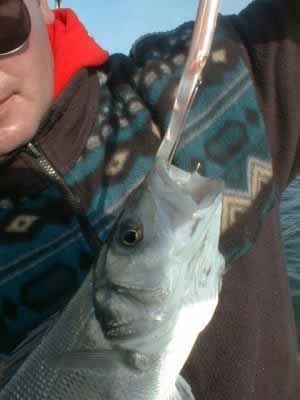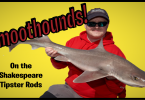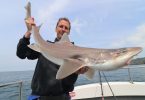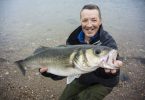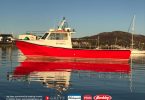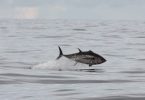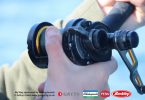LOCAL NAMES
Salmon-bass in Wales, sea salmon in Cornwall. Bass under 2lbs are called “school bass”, south coast and English Channel e referred to as “checkers”.
IDENTIFICATION
Carries two dorsal fins, the first with 8 or 9 sharp spines evident. A streamlined body shape with large scales. Also sharp spines on the rear of the gill cover and at the front of the anal fin. Hard to confuse the bass with any other UK sea fish.
COLOURATION
Varies depending on the ground which the bass is predominantly feeding. Usually green/grey on the back, but can be a pale to dark blue. Sides shade through silver to a white belly. Some bass have a hint of yellow around the head and gills and may carry a pale white spot on the junction between tail and tail fin. The eye is black surrounded by yellow.
BREEDING SEASON
Mainly March through to mid June, but some egg carrying females may be caught as late as mid July. Breeds both in offshore waters on reefs and rock patches, but also in the mouths of estuaries where the fish can sometimes be seen in the act of breeding. The eggs and larvae are carried inshore and frequent estuary creeks and run-offs.
 DISTRIBUTION
DISTRIBUTIONFound throughout the UK, but is strongest represented along the south and west coasts as far as southern Scotland in the west and in the east to the Wash. Other hot spots occur at Cambois in the Northeast, Troon and Dunnet in east and north Scotland. Ireland also carries a healthy stock of bass right around her coast, but again, it’s the south and west coasts that hold the greater numbers.
Also frequents the European Coast as high as Norway and is a resident southward through France, Spain and Portugal, the Mediterranean and North Africa.
HABITAT
One of our most adaptable species. Found offshore over reefs, uplifting sand banks, inshore wrecks, along rough ground and surf beaches, inside harbours, and will feed to the highest reaches of an estuary and is often taken by salmon anglers fishing the junction of fresh and saltwater.
DIET
Enjoys a varied diet and is an opportunist feeder taking advantage of what ever is easily available at the time.
Crab, prawns and small rough ground living fish like gobies and rockling are found most frequently in fish feeding over rocky ground. Estuary fish take mainly crab and sandeel, but also small flatfish. Offshore reef fish get preoccupied with sandeels or small joey mackerel. Very large adult fish are true cannibals and occasionally contain small school bass, also whiting, eels, pipefish etc.

SHORE TACTICS
SEASON
The smaller school bass along the south and west coasts can be caught throughout the year, though there is a downturn in numbers during February the coldest month.
The adult fish come back inshore in the south and west from mid April, sometimes earlier in mild seasons. They stay until late October in the west, late November or early December in the deep south.
The east coast fish arrive in May and stay until late October if the weather remains warm without prolonged frosts.
Scottish fish are later. It’s June before they become a viable target, though they’ll stay well into October, even at Dunnet in the far north.
MARKS AND FEATURE
On the rough ground beaches, the bigger and more ill fitting the boulders are, the better the bass will work the area. Food washed down by the tide will fall in between the rocks and boulders and lodge where the bass can pick it up. Even on less rough marks where the rocks are smaller and tight fitting, if you walk the beach you will find areas where the boulders are larger than normal. These are the places to concentrate on.
Also look to weed beds, anywhere a small stream or river flows across the beach, finger like reefs that work seawards, and definite deeper gullies that come inshore from the low water line that fish will follow.
On surf beaches bass can sometimes follow a route along the slightly deeper gullies that run parallel with the beach. But they will also be side tracked by areas of boulders and weed growth, shingle banks, and again areas where a stream flows into the sea. On smaller beaches flanked by rocky cliffs it’s always wise to start fishing at each end of the beach near the rocks, rather than in the middle of the beach.
Inside estuaries, bass travel as the new flood tide starts to push over the estuary bar. They will work reefy ground and the sandbanks around the bar, then use the main channel to push far up the estuary. They investigate the sides of the estuary where the weed is thick and the crabs in numbers. Also, smaller side creeks which hold sandeels and flatfish.
Harbours, piers, breakwaters and marina’s all hold bass. They come in to feed on the smaller pout etc, that are feeding on the rubbish and old bait that commercial fisherman and anglers throw over the side. Also, anglers leave a trail of small pout, rockling, poor cod etc, that expire after unhooking which the bass mop up with glee.
TIDES
Bass will work estuaries even on the smallest tides. This is because of the continued tidal run through the main channel that always displaces food items. Over the rough ground and surf beaches bass numbers will decline as the neap tides reach their lowest peak. This is because the lack of tide fails to disturb enough food forms for the bass to fill their bellies.
On the beaches the best tides are the middle sized ones and those just prior to the very biggest springs. The biggest springs themselves can be disappointing, though odd fish can still be caught.
WEATHER
Bass like rough weather. Not full blown gales, but those days when the wind comes off the sea at a steady force 3 to 6 creating a series of rollers that push across the sand and rocks and again expose food. Winds off the land that clear the water push the bass out to deeper water where they feed on the reef sandeels etc.
The other good time is just after a strong gale when the sea has been really rough and the surf is full of weed. Bass will work within a few yards of shore in these conditions.
Bass will feed by day if the sea is coloured or carrying a good surf. Generally, the fishing is best at night, especially dusk and dawn, but bass respond more to the state of the tide than the darkness of the hour./P
TECHNIQUES
ROUGH GROUND BEACHES
Bass show over these beaches only at set times. It’s usually low water and the first two hours of the flood, then the hour either side of high water. Outside these periods bites are few and far between.
Long casts are not necessary. Dropping a large crab bait at about 40-metres or less will usually find the fish. But you need to hold the rod at all times and feel for the bites being transmitted through the rod. Bass mostly register on the rod tip initially with a couple of gentle knocks, then pull the rod tip hard over. You need to strike as the rod is pulled away from you.
SURF BEACHES
In rough weather and heavy surf’s, use a wired lead to anchor the bait in position, but again hold the rod and feel for bites. Start by casting out to medium range, then if no bites are forthcoming shorten the casts until you’re working only 40-metres out, and if this fails to produce fish do not hesitate to put a bait as far as you can. It’s a mistake to believe the books and articles that suggest bass are always close to shore. The truth is that the bass are where the food is, and this may beyond even the best casters at times.
In less rough seas and steady surf’s, it pays to use a plain lead and let this roll with the tidal pressure on the line in a downtide and inward arc. The bait and lead then find all the depressions and gutters that the bass are likely to be feeding in.
ESTUARIES
These require a mix of the latter two techniques. The bar and main channel of the estuary may need to be fished with wired leads on a flooding tide, though if you pick a place just off the main current you can choose a plain lead and let the bait move across the seabed, again finding out and resting in the food holding depressions.
The creek and estuary sides need very short casts, often less than 20-metres and putting the crab bait down into the weed and rocks where the bass are hunting. Cast beyond these edges and you’ll only catch flatfish.
SPINNING
Bass working the rough ground beaches, estuary bars and creeks will just as readily hit an artificial lure. The best are the ABU Toby spoon, the Dexter Wedge and the Redgill artificial sandeel.
Simply casting and retrieving the lure over the rough ground will catch bass, though you’ll find that more fish are concentrated for this type of fishing around the river mouths and streams. Also try working the lure along the small finger reefs. Plugs work well, too, especially the slimmer bodied floating ones in silver and jointed ones that give off vibrations.
Inside the estuaries, aim to fish where the main channel has a bottleneck that forces the water through a narrow gap quickly. Bass will herd up the sandeel shoals against this passing current with three or four fish making charging runs into the sandeel to feed. A white or black Redgill can be deadly at this time.
TACKLE
For most rough ground bassing and for average surf conditions a blank between 11-feet and 12-feet casting 2-3ozs is needed. Ideally, it should have a supple but not stiff tip, with power increasing quickly through it’s mid section to a stiffish butt. This stiff butt gives the power for you to turn and play fish away from snags when needed. Because it needs to be held throughout the session it should not weight much more than 15ozs. Add a multiplier like the ABU 6500 series or similar and load this with 15 to 18lb line, depending on how rough the ground is and how likely line abrasion will be.
Very rough sea conditions may see you step up to a 4-5oz beachcaster, even a full blooded 5-6ozs long range beach rod when the bass are working the low water sandbanks at high water. The reel for this rod would need to be either a 6500 type multiplier and 15lb line with a shock leader, or a 7000 sized multiplier and anything up to 30lb line to combat line cutting rocks and floating weed.
In calmer seas you can drop down to a light carp or spinning rod and just 1-2ozs such as in estuaries and off the beach in calmer weather. Fixed spool reels and 10-12lb line make for a balanced outfit.
RIGS
Keep the rough ground rig as cheap and as unobtrusive as possible. Take 30-inches (75cms) of 20lb line and tie a loop in the bottom by tying two granny knots. About 18-inches (46cms) above this tie in a blood loop to take the hook length. Use either a swivel, Mustad oval split ring or a link made from 18 gauge stainless wire with a small eye formed in each end as a main line to trace connector. The hook length should be 15lb line and about 9-inches (23cms) long. The hook to use is the Mustad Ultimate Bass 33751BL or the Mustad Viking 79515 between a 2/0 and a 5/0.
Tie a short length of 8lb-10lb line to the loop at the base of the rig and tie the lead to this so that the lead will break free if it gets stuck. Leads with a long tail which has a 45 degree dog leg at the end which sits inside the loop for casting but releases to remain attached by the weak line only is totally safe when fishing in company and will not prematurely release..
Surf beach rigs are similar in design. Use 30-inches (75cms) of trace line strong enough to handle the size of weight you’ll need. Tie a Mustad oval split ring at the base and add a small bait clip above this if longer distance is required. Use crimps and beads to trap a small swivel about 20-inches (50cms) above the split ring. Finish with a strong swivel at the top of the rig. The hook length should be about 18-inches (46cms) ending in a Mustad 3261BLN Aberdeen for worm baits, or the Mustad Bass with crab baits from 1/0 to 5/0 depending on bait size.
Simply putting a drilled bullet onto the main line stopped by a bead and swivel and adding a 24-inch (60cms) length of 12lb line is a good way to present a sandeel or crab bait in the estuaries when you want the bait to move around.
Use a three way swivel to rig an artificial Redgill eel. Tie the main line to the top swivel eye, use a 12lb hook length about 30-inches (75cms) plus long tied to the lower eye, and add a split ring to the middle eye which takes the weight. This casts quite cleanly and presents the eel well.
SHORE RECORD – 19lbs 0oz 0dr – D. L. Bourne, Southern Breakwater, Dover, Kent – 1988
SPECIMEN TARGET WEIGHT – 8lbs
BOAT TACTICS
TIDES
Offshore reef and sandbank bass are most abundant on the tides from mid size to the biggest springs. Bass working inshore wrecks are also likely to feed best on the bigger sized tides, but if the mackerel are close inshore and working around the wreck the bass will stay to feed on these during the neap tides, also.
Dinghies fishing just below the low water line and casting back inshore also need to target the bigger tides as the most likely fish producers. Neaps tend to give only the smaller 2lb fish and below.
WEATHER
As onshore, the reefs and sandbank fish let the tidal state rule, the weather itself is secondary, though when working closer to shore in prolonged settled conditions the hours of early morning and towards dusk offer the best chances.
LIVE SANDEEL FISHING
Over the reefs and sandbanks the bass are preoccupied by sandeel and sandeel only. Use a drilled bullet up to a couple of ounces for deeper water or over shallow reefs go for a barrel lead of about .5oz to 1oz. The hook length should be about 3-feet to 6-feet or 90cms to 180cms long. Some anglers prefer a small boom to take the hook length and keep tangles to a minimum.
Just let the tackle descend slowly keeping in touch with a tight line at all times. The bass should hit the eel on the way down, but also as you gently lift the weight off the seabed and start to very slowly raise it in the water. In light tidal areas a freelined sandeel is even better.
Mount the sandeel by using an Aberdeen hook and just nicking the sandeel through the top lip.
TROLLING
Trolling artificial sandeels behind the boat is an excellent way of fishing both the sandbanks and the reefs. Actually being able to detect the line of the reef as the tide flows over it and trolling the eels along this is essential for premium sport.
Rig the Redgill as follows. Tie a large 4/0 swivel to the main reel line and add about 6-feet (180cms) of 20lb line, preferably a clear mono, and tie on the Redgill. The large swivel gives the eel the necessary weight to work deep enough to attract the bass working below. There is no need to use a weight of any kind.
You need to adjust the boat speed to about 1 to 2 knots, no more. Allow about 75-metres of line to spill from the reel and then let the line come tight as the boat travels forward. A taking fish first feels like a slowly increasing pressure on the line, then the tip kicks over as the hook is pulled in.
Over the inshore wrecks try lip hooking a live joey mackerel and easing it out into the tide. This also works around the mouths of estuaries in high summer and when fishing the inshore reefs.
TACKLE
If the tide is running fairly quickly over the reef or sandbank choose an uptider casting 2-6ozs and 6500 sized multiplier. This outfit also does nicely for the mackerel bait technique. In a slack tide situation and when freelining the sandeels, go for a carp rod rated to cast 2-3ozs and a fixed spool reel loaded with 10lb line.
BOAT RECORD – 19lbs 9ozs 2drams – P. McEwan, off Reculver, Herne Bay, Kent – 1987
SPECIMEN TARGET WEIGHT – 10lbs
BASS FACTS
Bass are a sought after commercial catch and retail prices have exceeded £11 per pound in the past. Prices average between £4 and £6 per pound still.
Males rarely reach 5lbs in weight with all the big specimen fish being females.
Young juvenile bass up to a couple of years old show a heavy mortality rate during cold winters. Settled summers and mild winters suit them best with large numbers surviving to swell the populace.
To read more of Mike’s work, please visit www.worldseafishing.com

